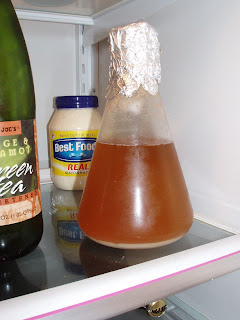Hey all,
Well here is another Wyeast smack pack problem. This is my first time working with liquid yeast and I think it might be dead. I received my yeast through the mail two days ago and decided to try it out yesterday morning. Taking it out of the box I noticed the package has a lot of air in it. It made it extremely difficult to break the nutrient packet open. After letting it sit for nearly 3 hours there was not even the slightest sign of activity. After reading some forum posts I decided to go ahead and continue making the starter. I added a 1/2 cup of DME to 1 pint of water. Boiled for 20 minutes, brought the temperature down to 70 degrees, poured into a sanitized container, and then opened the package and added the yeast. I noticed that there were two packets of nutrient inside and only one had opened. I popped that open and added it to the starter as well. Shook that up a little and now I am sitting at 24 hours later and there is still absolutely no activity.
Should I assume the yeast is dead or let it sit for another 24 hours? Did I do anything wrong? Any advice? Thanks in advance!
Well here is another Wyeast smack pack problem. This is my first time working with liquid yeast and I think it might be dead. I received my yeast through the mail two days ago and decided to try it out yesterday morning. Taking it out of the box I noticed the package has a lot of air in it. It made it extremely difficult to break the nutrient packet open. After letting it sit for nearly 3 hours there was not even the slightest sign of activity. After reading some forum posts I decided to go ahead and continue making the starter. I added a 1/2 cup of DME to 1 pint of water. Boiled for 20 minutes, brought the temperature down to 70 degrees, poured into a sanitized container, and then opened the package and added the yeast. I noticed that there were two packets of nutrient inside and only one had opened. I popped that open and added it to the starter as well. Shook that up a little and now I am sitting at 24 hours later and there is still absolutely no activity.
Should I assume the yeast is dead or let it sit for another 24 hours? Did I do anything wrong? Any advice? Thanks in advance!



